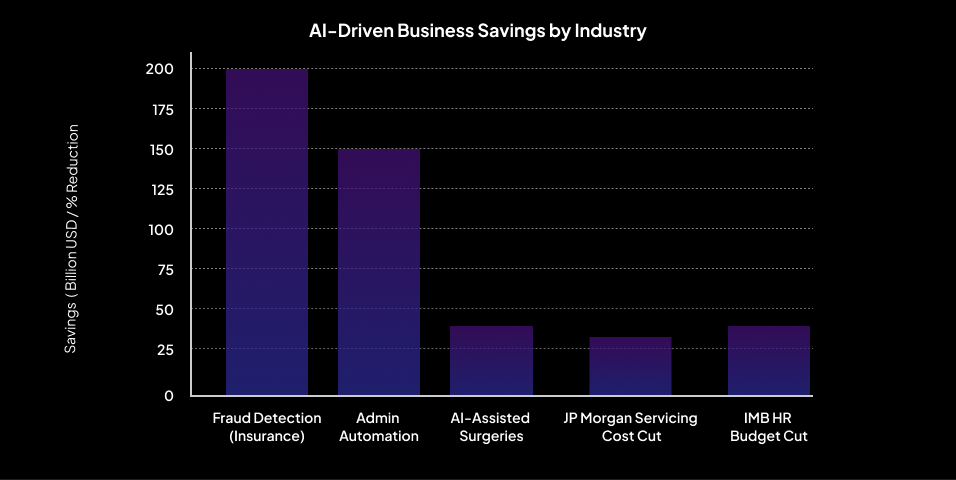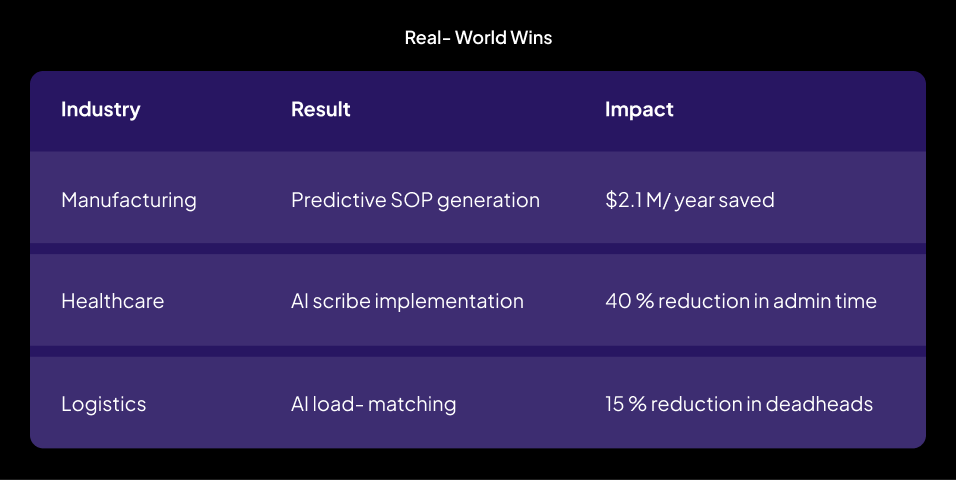How to Use Generative AI to Cut Business Costs & Boost Efficiency—Fast Results in Just 90 Days
In today’s competitive marketplace, scaling smarter with Generative AI is not just buzz—it’s bottom-line business. Tailored to industries like Healthcare and Real Estate, generative AI isn’t about sci-fi robots—it’s about reducing operational costs and unlocking efficiency in record time. Let’s dive in.
The 90-day mark isn’t arbitrary—it’s a tested sprint that aligns with leadership expectations, quarterly reviews, and market adaptability. Organizations that commit to transformation within this window often uncover process gaps that generative tools are primed to solve. It’s not about rushing—it’s about focusing. By aligning internal goals with AI-backed action, companies shift from ideation to impact in record time.
1. Why 90 Days? Fast, Focused, Impactful
Studies show implementers see ROI within a quarter. One analysis from Bain revealed that leading firms combining business process optimization with generative AI achieve cost savings of up to 25%, often within the first year, with early value appearing in as little as six months and ramping up thereafter.
McKinsey estimates that the global economic potential of generative AI could total $4.4 trillion over the next decade. Scale smarter with Generative AI by focusing on time-bound initiatives that deliver clear outcomes.
2. Workflow Liberation: Free Up Your Team’s Brainpower
Generative AI can do more than rewrite copy—it accelerates entire workflows.
- Manufacturing: Tools auto-generate SOPs, compliance docs, and training manuals, saving technical teams 8+ hours/month per person.
- Healthcare: AI scribes like Nuance DAX reduce the clerical burden by up to 50%, allowing clinicians to spend more time with patients.
- Logistics: Shipment tracking, order confirmations, and customer updates are auto-drafted, cutting human touchpoints and errors.
These tools don’t just support—they scale your operations while reducing manual load.
3. Cutting Costs Across Industries
Cost cuts aren’t conceptual—they’re happening now.
Smart Manufacturing
- Predictive maintenance lowers downtime by up to 50%, cuts maintenance costs by 18–25%, and slashes breakdowns by 70%
- IBM & Oracle report 15 %+ gains in uptime and 25% labor productivity boosts.
- Factories integrating AI-driven inspections—e.g., Gecko, Aquant—save up to 23% in service costs, avoiding failure cascades.
Healthcare
- Fraud detection AI curbs fraud losses by $200 billion/year.
- Admin automation slashes manual overhead by 20–30%, saving time and avoiding errors. Logistics
- Route optimization systems like UPS ORION save 10–15% on fuel, slashing fleet costs and cutting deadhead miles by similar margins.
- AI in warehousing (robotics + vision systems) reduced labor by 30% and errors rose to 98% accuracy, collectively slashing warehouse costs 40–50%.

4. “Companies deploy AI hiring cost avoidance” & Labour Optimization
Generative AI slashes expenses by:
- Automating draft job descriptions and interview questions.\
- Handling routine candidate communications—saving HR dozens of hours weekly.
- Screening resumes via AI, reducing man-hours and bias.
Keyword hits:
AI-driven labour cost optimisation solutions. These tools handle volume jobs, freeing human talent for strategy.
Modern HR is being redefined by companies deploying AI hiring cost avoidance strategies that streamline recruitment cycles and lighten the administrative load. What once took days—resume screening, candidate follow-ups, interview prep—is now reduced to a few AI-driven interactions. The secret sauce? AI-driven labour cost optimisation solutions that focus on freeing HR teams to do what matters: building culture, not just filling roles.
Example: JPMorgan’s internal generative AI suite has cut servicing costs by nearly 30%, trimming operational headcount by ~10%. IBM replaced hundreds of HR roles with AI, slashing HR budgets by 40%.
AI streamlines recruitment and candidate engagement.
- Manufacturing: Auto-generates job postings, schedules interviews, and performs screening, cutting HR time by 40% per hire.
- Healthcare: Automates credential checks, document prep, and candidate outreach—reducing onboarding lags.
- Logistics: AI reviewers vet resumes for warehouse and driver roles based on skill and fit, improving the quality of hire.
The result: shorter cycles, adaptable talent pipelines, and fewer manual touchpoints.

5. Boost Business Efficiency with AI & Business Process Optimization
From Bain’s “zero-based redesign” to McKinsey’s insights, success demands a holistic strategy:
- Redesign workflows end-to-end.
- Embed generative AI for repetitive tasks.
- Measure P&L impact early and course-correct fast.
Charter Global notes that automating repetitive tasks via generative AI reduces operational costs and frees teams for high-value work. RSM US reports up to 80% gains in compliance efficiency after AI integration.
6. Process Optimization: Speed, Quality & Compliance
AI isn’t just tooling—it enables smarter operations.
- Manufacturing: Production schedules auto-adjust via AI demand simulators, reducing bottlenecks.
- Healthcare: SOAP-note generation and billing code suggestion cut compliance errors by up to 80%.
- Logistics: Procurement and vendor messaging run on AI agents, streamlining systems and audits.
These integrations lower human error and enable scaling without breaking quality or compliance.
7. Boost Sales Efficiency & AI for Business Process Optimization
Sales leaders today are learning to scale smarter with Generative AI by moving beyond manual prospecting and reactive follow-ups. The modern sales stack includes AI tools that automate everything from lead scoring to email personalization, freeing up reps to focus on closing. This isn’t about replacing people but amplifying performance through intelligent automation.
- AI crafts data-driven outreach emails that are tailored, fast, and scalable.
- Lead scoring through AI increases close rates.
- Follow-ups are automated through AI agents, keeping prospects engaged even when reps sleep.
McKinsey says applying gen AI could bump sales productivity by 1.2–2.0% of annual revenues—a $400–660 billion impact in retail and CPG.
8. Real-World Impact: Success Stories

9. Risks & Guardrails
- Avoid cost traps: Custom AI models can run into $2–200 million—stick with commercial tools for pilots.
- Define metrics upfront: Without KPIs, ROI is an illusion. Measure time, error, and cost.
- Embed ethics: Especially in hiring and patient care, ensure AI is fair and transparent.
Final Word
Don’t Just Ask What AI Can Do. Ask What It Can Save.
Whether you’re navigating patient volumes in Healthcare, managing supply chains in Logistics, or running lean on a Smart Manufacturing floor, generative AI isn’t just a tech experiment. It’s a line item that changes your quarterly P&L.
In just 90 days, businesses are reporting measurable wins:
- Fewer manual hours in claims and admin.
- Faster onboarding across factories and field teams.
- Shorter sales cycles, from lead to conversion.
- Reduced burnout in frontline roles, especially in sectors plagued by documentation fatigue.
So, how does AI cut costs?
Not through gimmicks, but through laser-sharp interventions:
- In healthcare, AI writes SOAP notes, triages patient queries, and slashes documentation time by 50%.
- In manufacturing, it optimizes maintenance schedules and drafts job cards, freeing skilled labor from repetitive inputs.
- In logistics, AI streamlines route planning, automates load matching, and answers inbound service requests—without expanding headcount.
These aren’t moonshots. They’re practical deployments where operational friction lives—and where time and money quietly leak away.
Bottom Line?
Boosting efficiency with AI isn’t a luxury—it’s a survival strategy. And in industries where margin pressure never lets up, your competitive edge starts with a well-deployed model.
So why wait? Start small. Track impact. And let the efficiency gains stack up—month after month.
FAQs
1. How to use AI to generate sentences for business?
Use AI-powered writing tools—like ChatGPT, Wordtune, Grammarly, or Canva Magic Write—to generate, refine, or rewrite business communications. Paste your draft, set tone/style, then let AI suggest professional sentences, headlines, or email templates—saving hours weekly.
2. How can generative AI contribute to cost-cutting in business operations?
By automating complex and repetitive tasks across processes—content creation, procurement, fraud detection, and admin workflows—generative AI reduces manual effort, error rates, and resource use. One Bain study found that top companies combining AI and end-to-end redesign can save up to 25% of costs.
3. How does AI improve business efficiency?
AI boosts efficiency by automating routine work (e.g., data entry, documentation, customer support), delivering rapid data analysis, and 24/7 service. This frees teams to focus on strategic initiatives and enhances customer satisfaction.
4. In what way can generative AI boost sales efficiency?
Generative AI helps sales teams by drafting tailored emails, proposals, pitch decks, and call summaries; prioritizing leads; generating forecasts; and tracking KPIs. AI leads to faster follow-up and higher close rates.
5. How does AI help with cost reduction?
AI reduces costs through: predictive maintenance (cutting downtime), robotic process automation (RPA), optimized supply chains and demand forecasting, reducing errors, and resource waste—leading to up to 40% productivity gains.
6. Can generative AI show ROI in just 90 days?
Yes. Many firms see meaningful ROI within 90 days by targeting quick-win areas (admin, content, customer support), setting measurable goals, and integrating off-the-shelf tools. Early wins often trigger full-scale ROI within a quarter.
7. Which industries benefit most from cost savings through generative AI?
Industries like healthcare, insurance, finance, and real estate lead with high ROI. Examples include AI trimming $150 B/year in admin, $200 B/year in fraud detection, and reducing hospital stays by 20% via assisted surgeries.
8. What are the best practices for a 90-day AI rollout?
- Choose a quick-win: e.g., content automation or lead qualification
- Set SMART targets: e.g., “Generate 50 emails/week, reduce super admin time by 30%”
- Deploy and train tools: integrate with existing workflows and upskill teams
- Track metrics daily/weekly: time saved, error reduction, cost impact
- Iterate & scale: expand to strategic processes and consider end-to-end redesign








